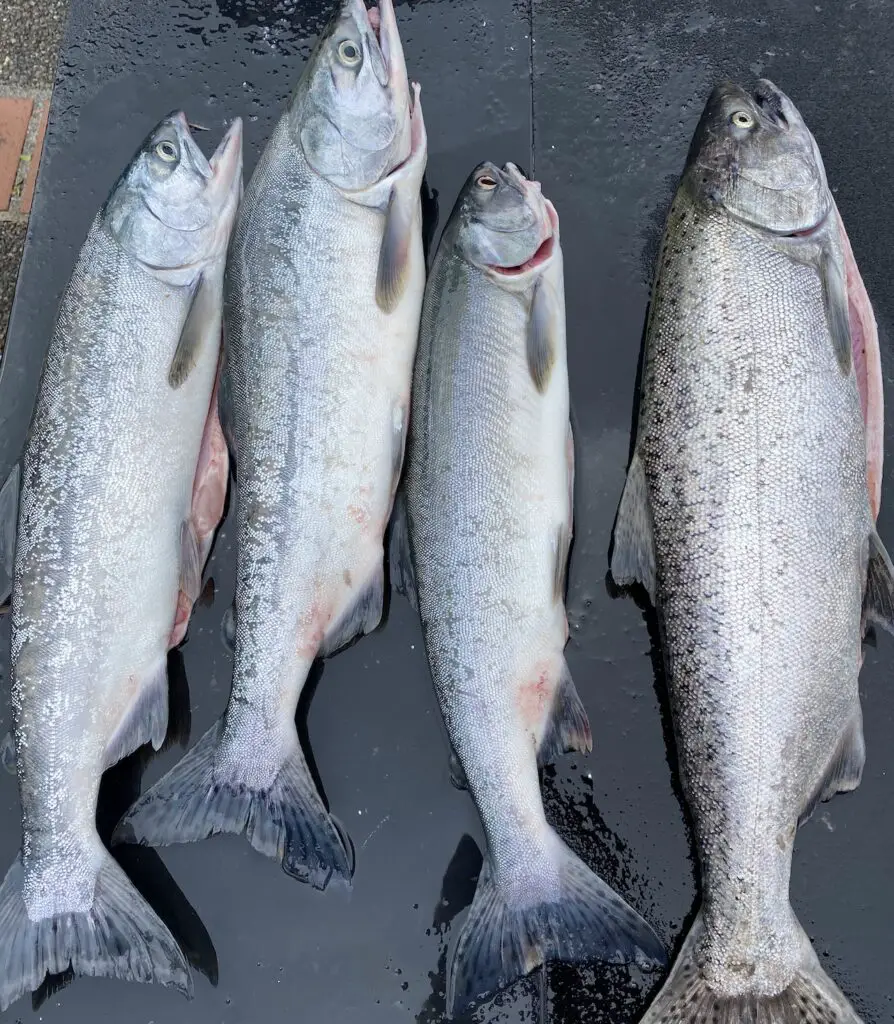
Puyallup River salmon fishing is a local annual tradition that anglers from all the nearby areas flock to participate in. Once boasting great returns of both salmon and steelhead, now the river is a magnet for odd-year pink salmon anglers and those who focus on the often abundant runs of kings (chinook) and silvers (coho) each year.
The Puyallup River emerges from the western flanks of Mount Rainier and is joined by key tributaries: Carbon and White Rivers within the Orting and Puyallup valleys, respectively.
Major hatcheries exist on the Carbon and White rivers, but only the Carbon is run by WDFW and feeds into the escapement graphs shown on this page.
The White River hatchery is run by the Puyallup Tribe. There is typically a season on both the Puyallup and the Carbon River, but not on the White. Oftentimes, the best fishing is on the Puyallup mainstem before the confluence with the White River as many of the salmon are headed there.
Fall chinook salmon fishing on the Puyallup can be fantastic when it typically opens in mid-August. These salmon will enter the river as early as July and work their way slowly upriver toward the White and Carbon River hatcheries.
The Puyallup is also well known for its usually strong runs of coho salmon. But the Puyallup River really gets a lot of attention in odd years, like this year in 2025, when the Pink Salmon invade the river and are so easy to catch.
This page will help you out with all of these fishing topics!
Puyallup River Fall Chinook Salmon Fishing 2025
Updated status on hatchery fall chinook salmon returning to the Puyallup River
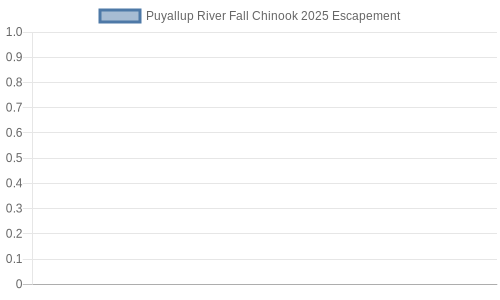
The above graph will update every Thursday typically with the fish that have returned to the hatchery on the Carbon River.
When to fish for fall chinook salmon on the Puyallup River?
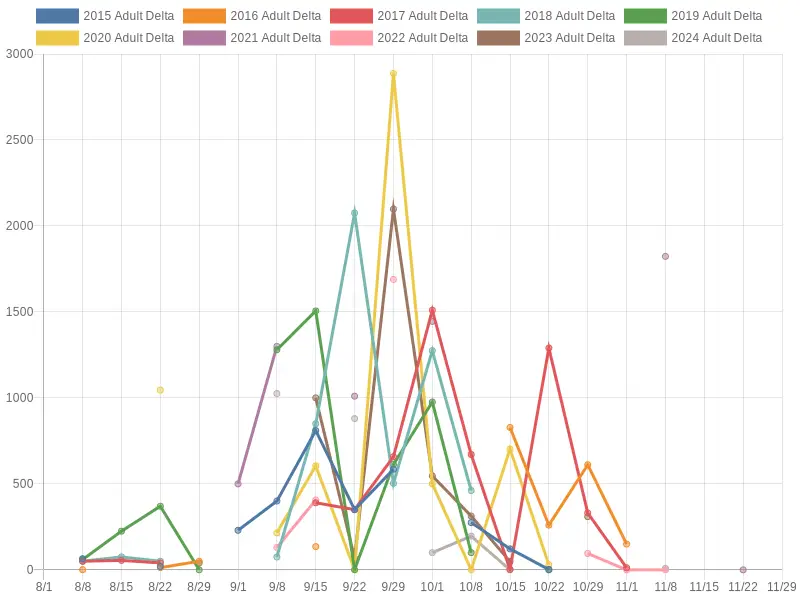
When looking at a chart like the above, you want to visually ascertain when the run really begins to be fishable in most years. Most years that’s as soon as it opens up in early August. It usually peaks in early September / late August though on the Puyallup, particularly the lower parts of the river.
Forecast for 2025 Puyallup River Fall Chinook Salmon
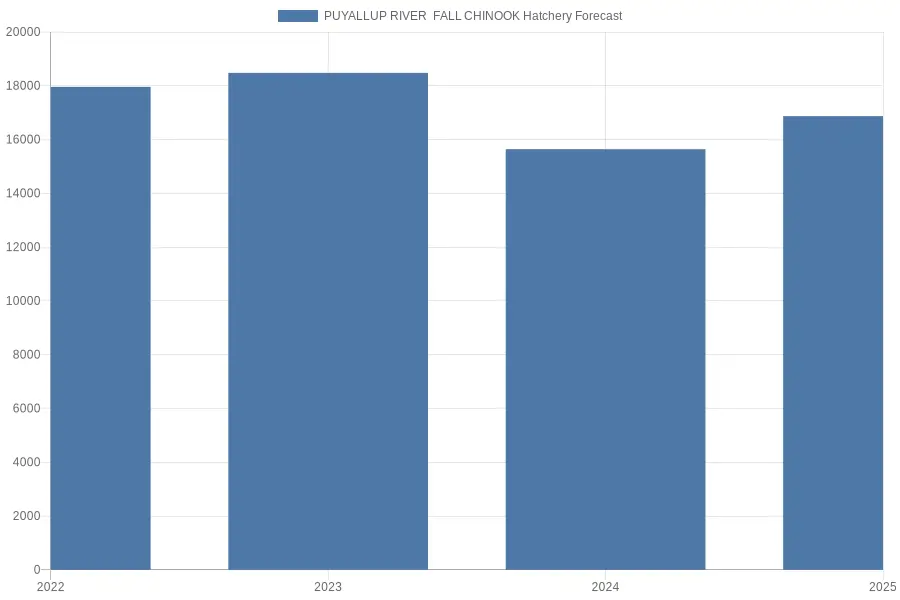
The forecasted run of fall chinook salmon on the Puyallup is expected to be higher in 2025 than in 2024 but beneath 2022-2023.
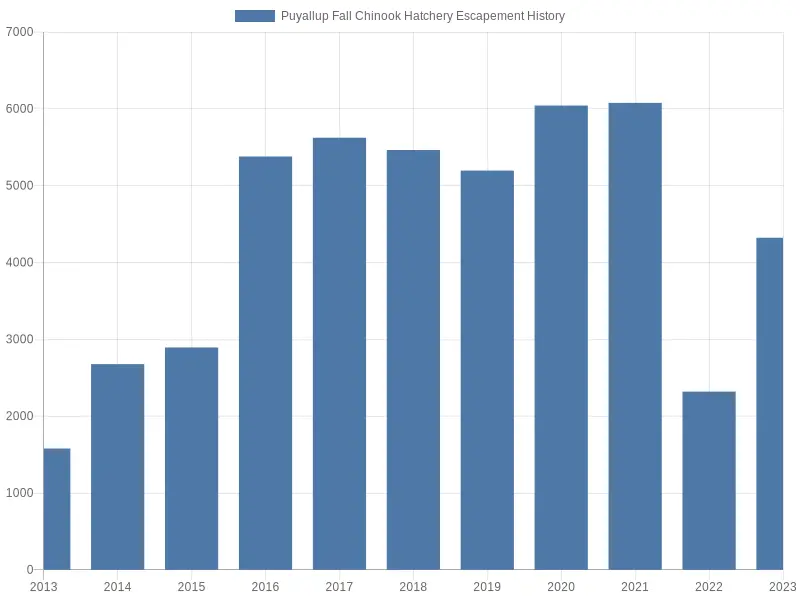
The escapement in 2023 was almost 2x that of 2022 despite a similar forecast. 2024 returns did come in less than the recent average, but 2025 could be a bounce-back year.
How to fish for fall chinook salmon on the Puyallup River?
Believe me, I get it. Just getting started fishing for salmon in the river can be pretty intimidating. You may have tried in the past and not had success, you may have grown up fishing, but never in the rivers for salmon.
Don’t worry, literally my entire website is here to help new people get started successfully in a variety of PNW outdoor harvest opportunities, but certainly, salmon fishing in the rivers is well within the wheelhouse.
Don’t find what you’re looking for? Drop me an email at kyle@pnwbestlife.com and I will attempt to answer your question directly.
So let’s look at a few articles, starting with a few guides to gear that may help you.
My guide to the best fishing rod for salmon will give you an idea of how to get started AND why you should buy a given salmon fishing rod.
My guide to the best fishing reel for salmon goes with the fishing rod guide to help you complete your setup.
Next, let’s take a deeper look at river fishing for salmon in general. River fishing for salmon is one of the most complete references to salmon fishing the rivers you will find on the interweb.
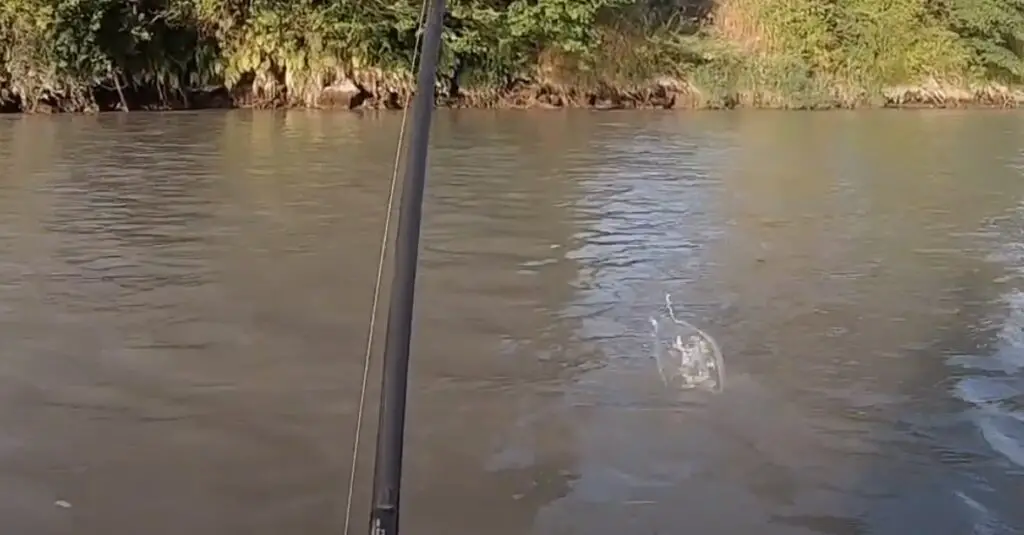
Why is the Puyallup River the color of a chocolate milkshake during the summer?
The primary source of summertime water in the Puyallup comes from melting glaciers on the slopes of Mount Rainier. While many rivers are sourced by freshwater springs, mountain lakes, or some combination, the Puyallup is almost entirely coming from that glacier melt water during the summer in particular.
Melted glacier water includes extremely fine particulates called silt or glacial till. The water is not “dirty” as some would believe; it’s also going to be quite cold and thus dangerous if appropriate precautions are not taken.
Here’s an example of how this impacts your visit to the Puyallup River:
If you are new to rivers, you may not know how to read the surrounding landscape and what it says about the depth of the water. Most people are used to “seeing the bottom” to determine the depth.
Well, how do you do that if you can only see through about 1″ of water in the Puyallup? You had better have a plan if you are stopping off the side of the road and hopping into the river. The spot you could be stepping into could be 6″ or 6′ and mean the difference between a nice day of fishing vs life life-threatening situation.
Here’s a few ideas:
- Hold on to something as you take that first step into the water
- Grab a nearby stick and use it to find bottom
- If the current is slow it’s more likely to be shallow (but not always!), if it’s fast and you cannot see bottom, don’t do it.
- Look at the surrounding land, does it gently slope into the water, or is the drop more vertical?
- My favorite: watch someone go in first 🙂
Know that the low visibility will also drastically impact fishing. To get a river salmon to bite in 1″ of visibility, you need scent, slow-moving bait, and to put it right at eye level.
What’s the best way to fish the Puyallup River?
You are going to want to use the drift fishing method because of what I wrote about the 1″ visibility. Drift fishing for salmon is covered in way more detail in the link here.
You might also try float fishing for salmon, but you need slow enough current, and you need to get your bait down to right in front of their face.
Why does everyone line up in the river and fish so close together?
The part of the river with the most fish per CFS of water is going to be the choke points. The choke points typically occur in the deep sections of gravel bars. Gravel bars are also super easy to wade on due to their gradual slopes and wide bank areas.
These spots will attract the most bank anglers. Classic bars on the lower part of the river like the “Soccer fields,” will be the busiest places on the whole river to fish. If you are looking for a little bit of privacy, you will need to find a place not so ideal for fishing.
It all depends on what you are hoping to get out of the fishing experience.
Why do people use such long drift leaders on a river with like 1″ of visibility?
People like it when the fish bite, but they also hate it when the guy or gal next to them is hooking a fish every cast and they aren’t. The answer? Longer leaders such that if the fish doesn’t bite, there’s at least a better chance for the line to run through the mouth of an upstream traveling salmon. A technique called flossing, you can read a ton about here.
Puyallup River Coho Salmon Fishing 2025
Updated status on hatchery coho returning to the Puyallup River
Coho salmon fishing on the Puyallup can be excellent, even as early as August when the river opens. You won’t expect to see large-sized coho typically until late October or into November, but fishing can still be great.

The above graph will be updated every Thursday typically with the coho salmon that have returned to the hatchery on the Carbon River.
When to fish for coho salmon on the Puyallup River?

When looking at a chart like the above, you want to visually ascertain when the run really begins to be fishable in most years. My favorite time to fish for coho salmon on the Puyallup is in late September when some rains and cooler temps improve the river clarity. With better visibility, I can toss lures for coho salmon and expect some savage takes!
Forecast for 2025 Puyallup River Coho Salmon
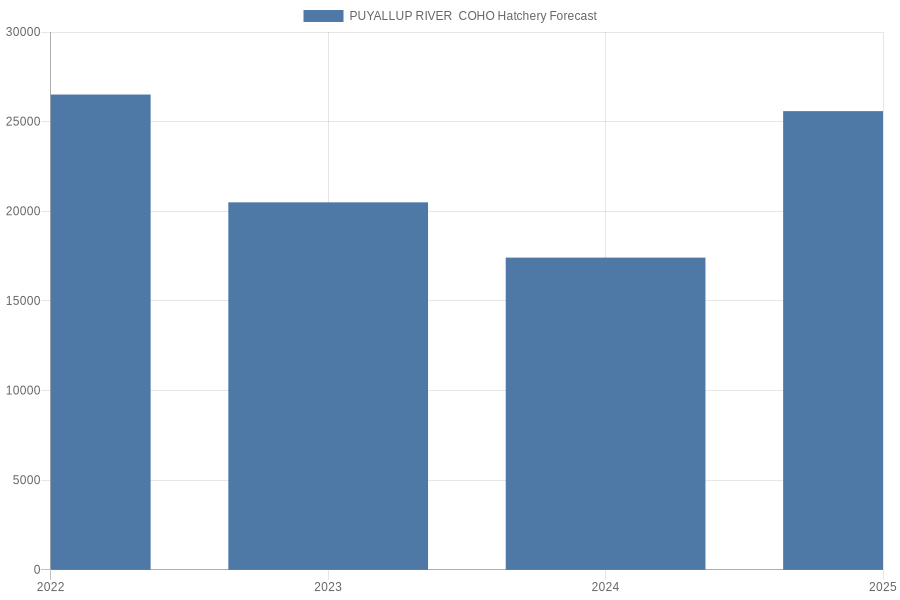
The forecasted run of coho salmon on the Puyallup is expected to be higher in 2025. We really need the wild component to bounce back though to have great fishing again for coho.
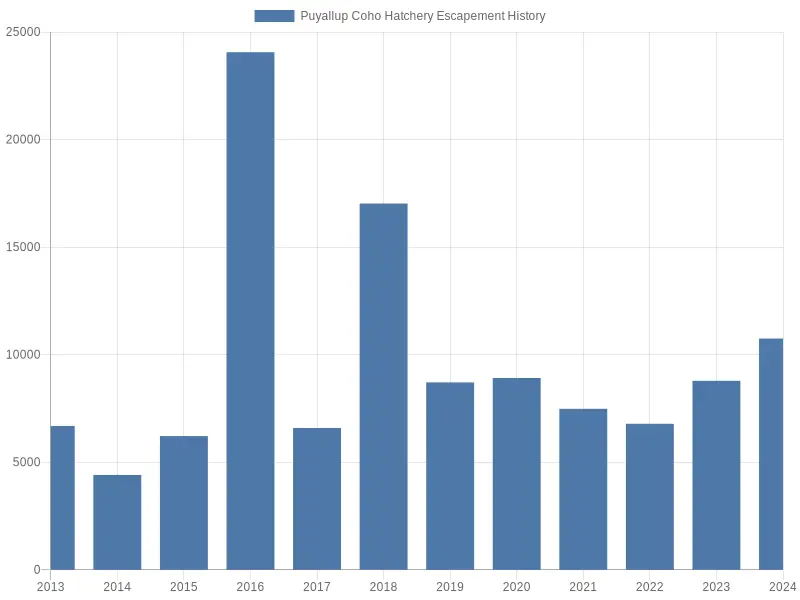
The hatchery escapement for coho in 2024 was an improvement on recent years, though only incrementally so.
How to fish for coho salmon on the Puyallup River?
I have several important resources on PNWBestLife.com and the YouTube channel to help you become a better winter steelhead angler.
The same information about chinook salmon applies here to coho except for one major difference: When the Puyallup River clears up you can use lures more effectively like spinners and jigs to catch coho salmon instead of relying on “drift flossing.”
The take of a coho salmon on a spinner is so much more fun than what a flossed fish feels like. Luckily for you, I wrote a complete guide to spinner fishing for salmon here that can help you get started.
You can also view the above video on my YouTube channel (PNW Best Life) for another way to consume similar material.
Puyallup River Pink Salmon Fishing 2025
Even though the pink salmon forecast in 2023 was lower relative to some other rivers, it still provided outstanding fishing!
Now in 2025, we can expect almost double the number of 2023! It’s not the 1.8 million pinks the Green is getting or even the 1.4 million for the Nisqually, but this is going to provide ample opportunity to stay hooked up all season long.
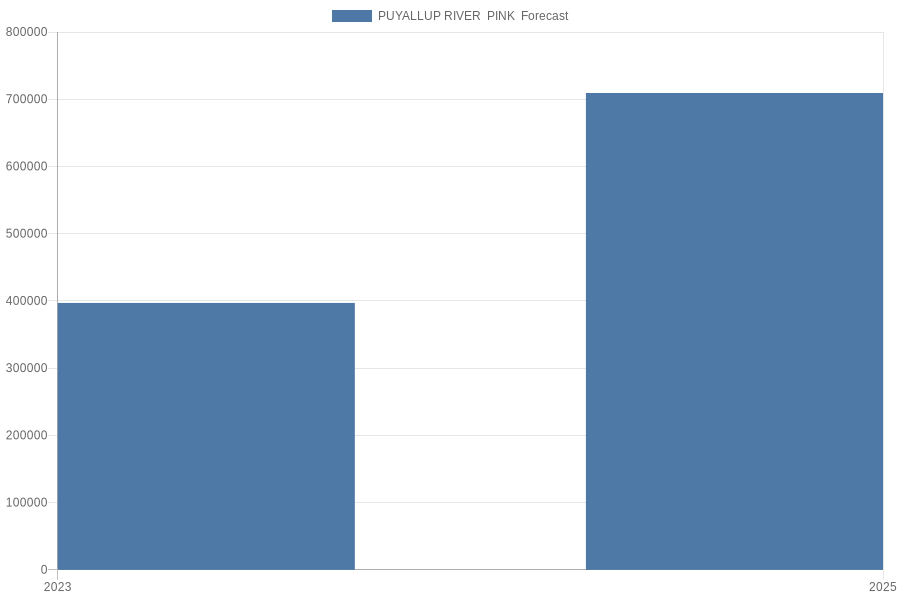
Current River Conditions on the Puyallup River
If you know anything about fishing for salmon and steelhead, it’s that the river conditions often determine your go/nogo decision.
Typically the Puyallup River has two distinct periods of river flow profiles. In the summer, the river is largely fed by the melting glaciers of Mt Rainier which is why it’s so silty and dirty looking with almost zero visibility.
As temperatures increase, the river flow will increase, even without rain due to more / faster glacial melt.
As we get into the rainy season, and temperatures start to cool off, you will see more river clarity, and the flow will be driven more by rain accumulation than glacial melt. Fishing can get really good for coho salmon once river clarity improves.
Puyallup River at Puyallup
For the authoritative but still provisional data refer to the Puyallup River at Puyallup gauge on the USGS site.
Warning: Below chart is in testing mode, data may not be reliable.
Puyallup River at Alderton
For the authoritative but still provisional data refer to the Puyallup River at Alderton gauge on the USGS site.
I like to look at Alderton for deciding to fish the Puyallup above the White River or even the Carbon River.
Warning: Below chart is in testing mode, data may not be reliable.
Fishing Regulations on the Puyallup River for 2025-2026
| Species | Date | Additional Rules |
from the 11th St. Bridge to 400’ downstream of Clark’s CRC (804) |
||
All species |
Aug. 16-Oct. 31 |
Night closure. Anti-snagging rule. Barbless hooks required. |
Aug. 16-Sept. 30 |
CLOSED Sundays, Mondays, and Tuesdays. |
|
Trout |
Aug. 16-Oct. 31 |
Statewide min. size/daily limit. Except: release cutthroat trout and wild rainbow trout. |
Other game fish |
Aug. 16-Oct. 31 |
Statewide min. size/daily limit. |
Salmon |
Aug. 16-Oct. 31 |
Min. size 12”. Daily limit 6. Up to 4 adults including no more than 2 adult Chinook or 2 adult coho or 1 of each may be retained. Release chum and wild Chinook. |
from 400’ downstream to 400’ upstream of Clark’s Creek |
||
All species |
CLOSED WATERS. |
|
from 400’ upstream of Clark’s Creek to East Main Bridge CRC (804) |
||
All species |
Aug. 16-Oct. 31 |
Night closure. Barbless hooks required. Anti-snagging rule. |
Aug. 16-Sept. 30 |
CLOSED Sundays, Mondays, and Tuesdays. |
|
Trout |
Aug. 16-Oct. 31 |
Statewide min. size/daily limit. Except: release cutthroat trout and wild rainbow trout. |
Other game fish |
Aug. 16-Oct. 31 |
Statewide min. size/daily limit. |
Salmon |
Aug. 16-Oct. 31 |
Min. size 12”. Daily limit 6. Up to 4 adults including no more than 2 adult Chinook or 2 adult coho or 1 of each may be retained. Release chum and wild Chinook. |
from East Main Bridge to Carbon River CRC (804) |
||
All species |
Aug. 16-Sept. 30 |
CLOSED Sundays, Mondays, and Tuesdays. |
Aug. 16-Oct. 31 |
Barbless hooks required. Anti-snagging rule. Night closure. |
|
Trout |
Aug. 16-Oct. 31 |
Statewide min. size/daily limit. Except: release cutthroat trout and wild rainbow trout. |
Other game fish |
Aug. 16-Oct. 31 |
Statewide min. size/daily limit. |
Salmon |
Aug. 16-Oct. 31 |
Min. size 12”. Daily limit 6. Up to 4 adults including no more than 2 adult Chinook or 2 adult coho or 1 of each may be retained. Release chum and wild Chinook. |
from Carbon River upstream CRC (804) |
||
All species |
Selective gear rules. |
|
Trout |
Sat. before Memorial Day-Jan. 15 |
Statewide min. size/daily limit. Except: release cutthroat trout and wild rainbow trout. |
Other game fish |
Sat. before Memorial Day-Jan. 15 |
Statewide min. size/daily limit. |
Please refer to WDFW’s emergency rules page for a full list of rules that are in effect.
It’s your responsibility as the recreational angler.
Why isn’t the Puyallup River above the White open 7 days a week anymore?
Historically, the Puyallup and Carbon Rivers are places you can fish 7 days a week for several months of the summer/fall, and thousands of people each year look forward to this wonderful part of the calendar.
However, in 2022 the fishing regulations have changed significantly, limiting how many days a week these rivers can be fished and the months they are open.
I recently reached out to WDFW with these exact questions on why things changed and here are the responses I received:
On why the Carbon and the Puyallup above the confluence with the White is not open 7 days a week:
Thanks for contacting WDFW about the salmon seasons in the Puyallup and Carbon River. The Carbon and upper Puyallup are closed Sun.-Tue. due to negotiations to reach agreement on a Regional Management Plan (RMP) for Chinook that secures ESA coverage for our Chinook fisheries for a 10 year period. The decision to extend the closure days to the upper Puyallup and Carbon was made to reduce impacts on wild Chinook in the Puyallup Basin in our collective fisheries in order to meet the management objectives that are part of the RMP. The wild population of fall Chinook in the Puyallup has continued to decline over the last two decades with an even sharper decline observed since 2009. Failing to reach agreement on the RMP would put coverage for all of our Chinook fisheries in Puget Sound in jeopardy.
In 2021, WDFW implemented a creel sampling study to provide estimates of salmon catch, releases of unmarked fish, and angler effort, with the intent of using the data and estimates to evaluate and improve management of the freshwater recreational salmon fishery in the Puyallup and Carbon rivers. As a conservative approach to management of the freshwater sport fishery while additional creel data is collected, the recreational salmon fishery in the Puyallup and Carbon will be limited to a maximum of 4 open days per week during times of Chinook presence (August-September). The extension of the closure days to the upper Puyallup and Carbon is to prevent effort shifts from the lower Puyallup to those areas which can increase impacts on wild Chinook migrating to the upper basin to spawn.
WDFW email
Where to fish for salmon on the Puyallup River
Here are some maps that show you where the regulations apply on a map.
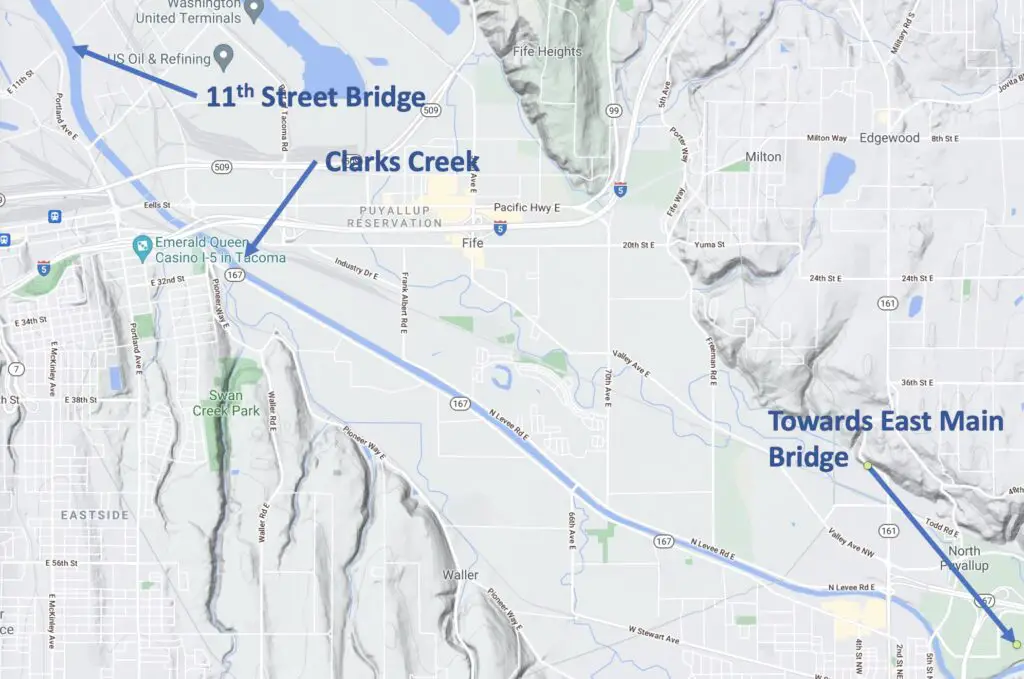
The stretch from the 11th Street Bridge to East Main usually experiences the most angling pressure and it’s also where salmon of all species are the freshest and provide the best quality table fare.
Additionally, many of the returning salmon on the Puyallup are headed to the White River. As soon as you go upstream of the East Main Bridge, you lose those white river fish.
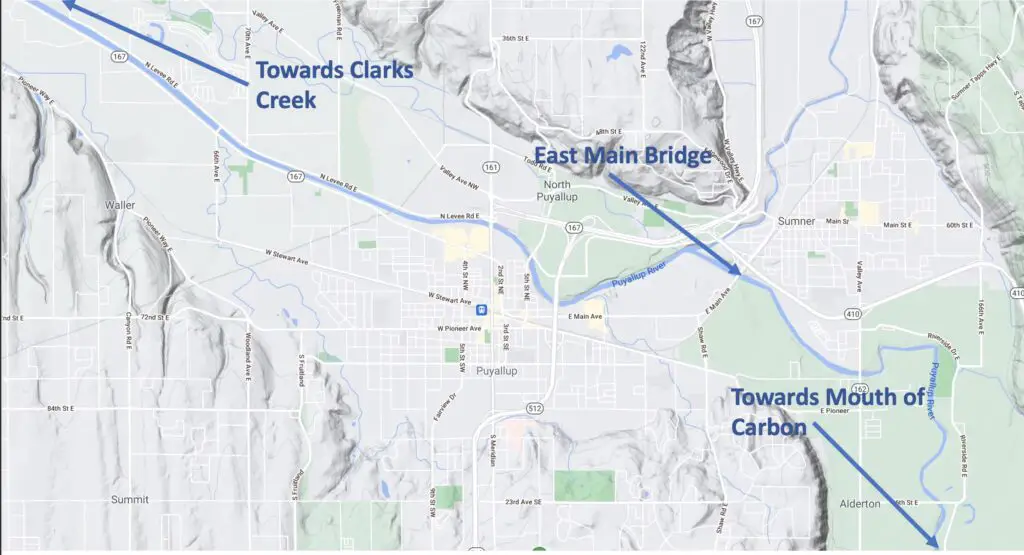
Here you can see, in the above map a more clear view of the white river coming into the Puyallup from the NE.
The stretch from East Main to the mouth of the Carbon River can also provide great fishing, albeit with less salmon and slightly less angling pressure
I would love to update this post and draw maps to all the popular spots to make it easy for folks, but it’s also pretty easy to just drive the roads on either side of the river and discover where everyone else is parking.
There really are no (almost no?) secrets here.
Restoring the Puyallup River’s natural origin salmon runs
The Puyallup River is one of those Rivers that run right through the heart of Pugetropolis, but its upper reaches are still wild and somewhat protected. If you’ve been paying attention at all to the whole salmon fishing scene around Puget Sound, you know the status of the natural origin runs is the most important factor in determining whether we have seasons or not to fish for hatchery salmon.
One of the helpful resources for understanding the state of these natural origin stocks and the biological opinion on their recovery and status levels is the Comprehensive Chinook Management Plan linked here.
The Puyallup Fall Chinook run is considered “healthy” (my words) at the upper management threshold of 1,538 fish with a low abundance threshold of 468 fish. They are managed at an upper ceiling of 30% exploitation rate for Southern US Fisheries and a 14-15% pre-terminal exploitation rate.
So where are we today?
Under this Plan, harvest limitations are not specifically designed to produce escapements that will consistently exceed the UMTs for all MUs. With reference to recent years, spawning escapements are expected to meet or exceed UMTs in some years for the Lake Washington, Cedar River, Green, White, and Puyallup MUs, accounting the aggregate of natural- and hatchery-origin adults that spawn naturally. For these MUs, harvest is not managed to achieve the UMTs exclusively with natural-origin adults, although programs are in place to sample spawners to determine their origin and to monitor the abundance of first-generation hatchery origin and natural-origin returns. Along with severely degraded and altered freshwater and estuarine habitats in these highly urbanized systems, they also have hydropower or diversion dam structures within the spawning and migratory reaches of listed Chinook salmon, altering stream hydrology as well as sediment and wood transport and recruitment. Passage at some facilities is available while lacking or severely impactful at others. Even with available fish passage, these structures will continue to affect passage timing by delaying migrations, and in some cases, increasing predation opportunities by marine mammals taking advantage of these migratory impediments.
Basically, the marine and freshwater environments are so altered that we don’t expect the natural origin runs to really thrive even with these management thresholds in place to limit harvest. That also means we are counting on some of the hatchery fish to stray to the spawning beds to keep the “natural origin” runs going.
Potential risks exist to genetic integrity and fitness of natural populations related to interbreeding between hatchery- and natural-origin Chinook Salmon. Domestication selection and other changes in genetic diversity occur in the hatchery environment, though improved culture practices are being implemented to mitigate these risks. Chinook salmon hatchery programs have been operating for decades in these watersheds as mitigation for lost natural productivity to due habitat destruction (NMFS 2014a).
We don’t have enough data to determine whether this whole plan of hatchery fish straying to the natural spawning beds is going to undermine our recovery efforts in the long run, but there really isn’t a better plan at this point due to the severe loss of habitat.
There is strong evidence that freshwater and to some extent marine habitat conditions are a significant cause given stable, if not declining trends in returns of natural-origin fish despite relatively strong returns of hatchery-origin fish to the respective systems/facilities (see Appendix A). The additive risk of hatchery-related fitness loss is uncertain, but we assume that population productivity will not recover significantly until the freshwater and marine habitat constraints are addressed. Habitat restoration and protection efforts, are ongoing in most watersheds and reliable assessments of the effectiveness of such actions will not be available for decades. However, the expectations of ‘no net loss’ of habitat for the Puget Sound Chinook Salmon ESU in the recovery plan (NMFS 2006b, Shared Strategy for Puget Sound 2007) have not been realized to date (Judge 2011, NWIFC 2012, NWIFC 2016) and co-managers, while continuing to support and implement habitat protections and restoration, have no indication that all appropriate jurisdictions will effectively address habitat declines to improve population productivity, as well as within population spatial structure and expression of diverse life-history strategies, for populations throughout the ESU.
Basically, we are still losing habitat despite our best efforts.
So with that in mind, let’s take a closer look at what’s going on with the Puyallup River Fall Chinook runs and habitat specifically:
Puyallup River Chinook are well below the planning ranges for recovery
escapement (Figure 4A), as well as below spawner recruit levels identified as consistent with recovery (NMFS 2006). In the Puyallup River, recovery planning ranges for escapement are 17,000 – 33,000 natural origin (NOR) Fall Chinook with productivities ranging from 1.0 – 2.3 recruits/spawner (NMFS 2006). The recent 10-year average spawning abundance for NOR Fall Chinook is 813 with a productivity of 0.9 recruits/spawner. Until habitat function is restored,
hatchery production will be essential to harvest opportunity in highly urbanized watersheds like Puyallup River.
So, in other words, the Puyallup River should support natural origin spawners of 17,000-33,000 chinook, but right now, we are around 813. Yikes!
So what are we doing about habitat restoration in the Puyallup River?
Here’s the Ecosystem Recovery Plan from PuyallupWatershed.org
From that document, below are the 50-year Habitat goals and the 10-year implementation goals:
To address limiting factors and support salmon recovery in the Watershed, the Lead Entity has developed 50-year habitat goals and 10-year implementation goals:
50-Year Habitat Goals:
- 32,000 acres of floodplain habitat (including in estuary and nearshore areas) are protected from
development within the Core Salmon Habitat and Flood Zone Protection Corridor by 2067;- 3,300 acres of functioning riparian buffer, with a width equal to or greater than one site-potential tree
height (to be determined), will define a protected Riparian Buffer Zone by 2067; and- 62 stream miles open to fish movement and passage by 2067.
10-Year Implementation Goals:- 203,000 linear feet of levees removed and 2,300 acres of floodplain reconnected by 2027;
- Ten percent increase in functioning riparian buffer habitat by 2027;
- Three major physical barriers to fish movement and migration removed or modified by 2027; and
- 153 acres of nearshore habitat is restored by 2027.
One example of success linked in the plan that I thought was compelling was the South Prairie Creek Floodplain Restoration here.
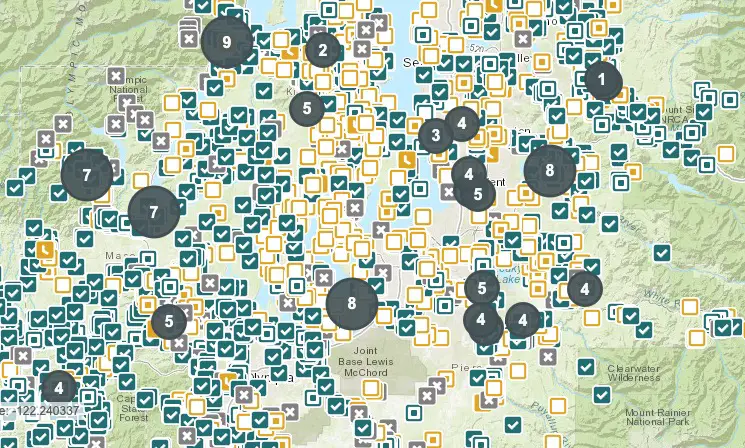
The above map shows a view of all the salmon r,ecovery projects completed, active or planned. Here’s the source for that map view.
A question I will continue to seek an answer to is: What can the engaged public do to benefit these projects?